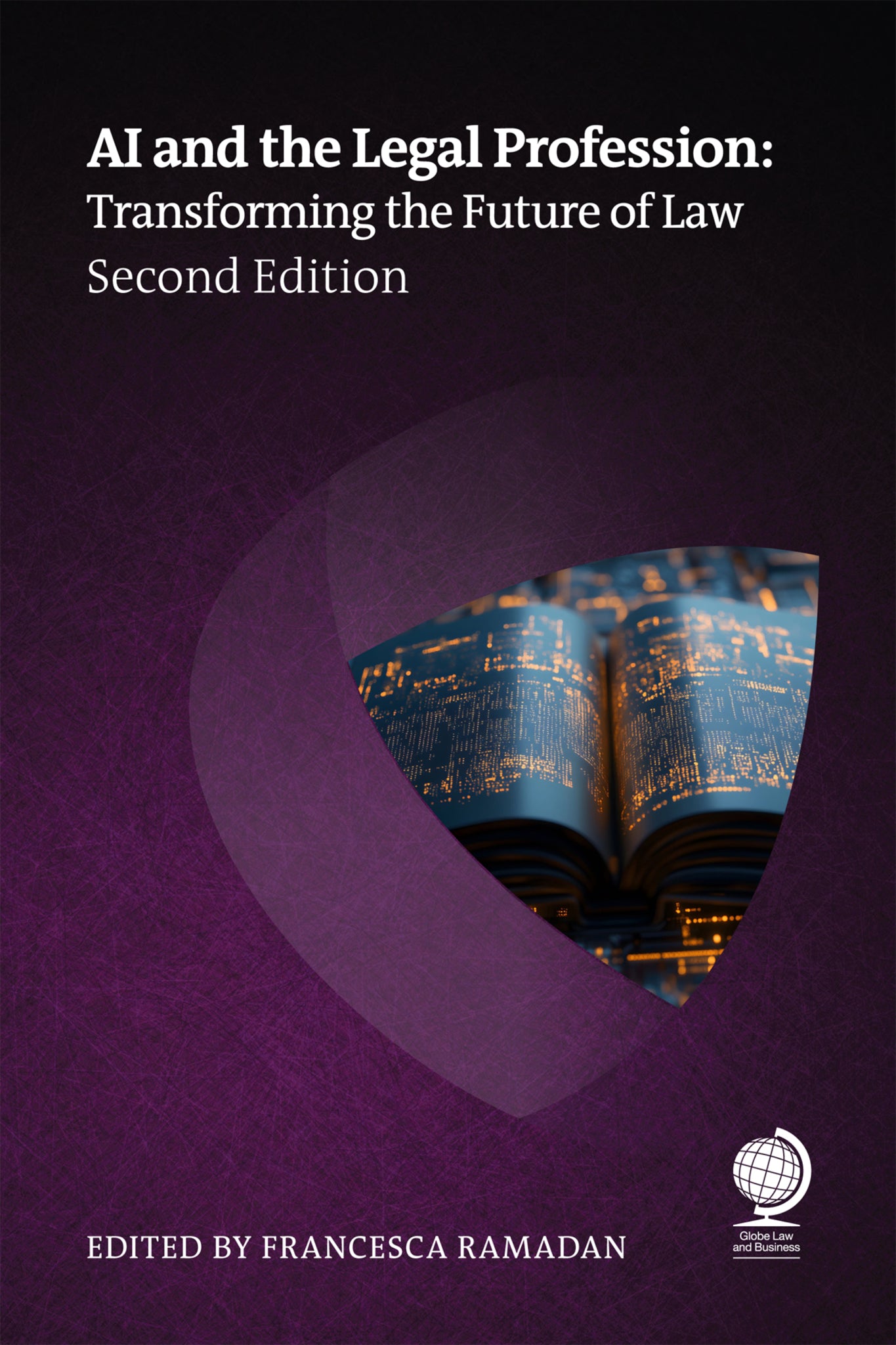We're sorry. An error has occurred
Please cancel or retry.
AI and the Legal Profession, Second Edition
Regular price
£159.00
Sale price
£159.00
Regular price
£159.00
Unit price
/
per
Sale
Sold out
Only -3 units left
The second edition of AI and the Legal Profession: Transforming the Future of Law acts as a guide, helping readers navigate this new frontier by delving into the impact of AI on the legal industry ...
Read More

Some error occured while loading the Quick View. Please close the Quick View and try reloading the page.
Couldn't load pickup availability
- Format:
-
25 June 2025

The capabilities and applications of artificial intelligence (AI) are evolving at breakneck speed, and law firms and practitioners may be at a loss as to how to make the most of what these new technologies offer. The second edition of AI and the Legal Profession: Transforming the Future of Law acts as a guide, helping readers navigate this new frontier by delving into the impact of AI on the legal industry and the transformative possibilities it presents.
The fear that AI will replace lawyers has been exorcised; however, questions remain as to how AI is best used as a complementary tool. This book provides the answers by exploring the ways in which AI is revolutionising legal practice – including research, document review and examination, and predictive analytics – and elements of law firm operations, such as billing, pricing, and recruitment and retention. To achieve maximal outcomes, human collaboration with legal AI is key: AI and the Legal Profession, second edition underscores the importance of human judgment in AI usage and offers roadmaps to upskilling existing teams, finding and keeping new talent, and improving work–life balance.
Integration and development of AI is often one of the biggest hurdles firms must overcome. This book provides practical guidance for those exploring the two paths to AI implementation – building in-house, proprietary tools or seeking existing solutions from external vendors. Topics covered include needs assessment, process mapping, and goal-setting; build vs buy analysis and vendor selection; planning, customization, and integration; and evaluation and future-planning. Insights into current and upcoming regulatory developments, such as the EU’s AI Act, offer instruction as to what kinds of systems and processes will need to be embedded to ensure compliance.
It is no secret that AI brings challenges alongside opportunity, mainly related to accuracy, ethics, and privacy. AI and the Legal Profession, second edition examines whether safe, sustainable, and secure AI in law will ever be possible. It offers insight into navigating copyright challenges in the era of AI and delves into the protective measures necessary to protect client data and maintain confidentiality.
Written by leading experts, thought leaders, and professional and academic pioneers at the intersection of AI and law, AI and the Legal Profession: Transforming the Future of Law, second edition serves as a comprehensive guide for legal professionals, technologists, and policymakers, equipping readers with the knowledge and insights needed to navigate a rapidly evolving landscape, embrace AI's potential, and harness its power to shape the future of law.

Price: £159.00
Pages: 221
Publisher: Globe Law and Business
Imprint: Globe Law and Business
Publication Date:
25 June 2025
Trim Size: 9.25 X 6.12 in
ISBN: 9781837230884
Format: Paperback
BISACs:
LAW, Legal Profession, Law, Legal profession: general

Executive summary vii
About the authors xiii
Chapter 1: Artificial intelligence, authentic practice: the uneasy partnership reshaping legal services 1
By Colin Levy, general counsel, Malbek
The intersection of human judgment and AI capabilities 2
Governance frameworks centered on human judgment 4
Developing judgment skills for AI-augmented practice 9
Professional standards for human–AI collaboration 14
Conclusion: A balanced vision for human–AI legal practice 18
Chapter 2: The law, genAI, and us: a journey into the future of legal thinking 23
By Dr Valérie M. Saintot
How genAI is changing our thinking 24
A proposal to reclaim and train the legal mind 28
A genAI prompting accountability checklist 35
Conclusion 37
Chapter 3: Challenges and ethical considerations in the age of generative AI 39
By Natalie Pierce, partner and chair of the Employment & Labor Group, and Stephanie Goutos, head of employment law practice innovation, Gunderson Dettmer
Introduction to ethical challenges 39
Challenges and professional obligations when using genAI 42
Failing to leverage genAI responsibly may create serious risks 45
Best practices for lawyers to manage risks relating to genAI 48
Conclusion 52
Chapter 4: The data drain: navigating copyright challenges in the era of AI 63
By Joanne Brook, consultant solicitor (intellectual property and technology law), Lionshead Law
AI training data: who owns the engine, and who owns the oil? 63
Claiming back copyright 65
AI copyright for a bicentennial brain 68
Does AI need an “Asenion Law”? 69
Information wants to be shared 70
But is it art? 72
Same old new law 73
Chapter 5: The legal technology playbook: a step-by-step guide to implementing legal technology 79
By Justin Turman, founder, Automate Office Work
Phase 1: Needs assessment, process mapping, and goal-setting – a strategic approach 80
Phase 2: Build vs buy analysis and vendor selection choosing the right path 83
Phase 3: Pilot program or proof of concept – testing before scaling 85
Phase 4: Planning, customization, and integration crafting a cohesive solution 88
Phase 5: Training and change management – cultivating confidence and adaptability 90
Phase 6: Implementation and rollout – executing with precision 92
Phase 7: Monitoring, feedback, and continuous improvement sustaining success 95
Phase 8: Planning for updates, enhancements, and scalability – future-proofing your legal tech 97
Phase 9: Evangelizing success and expanding use – igniting a culture of innovation 99
Phase 10: Evaluation and future planning – reflecting to propel forward 101
Conclusion: Embracing the future of legal practice 103
Chapter 6: Managing expectations: practical steps to achieve successful AI implementation 107
By Mark Gediman, senior research analyst, Alston & Bird AI cannot replace good old-fashioned legal research… yet 109
Determining the best AI tool(s) 110
Conclusion 114
Chapter 7: The global impact of the European Union’s
AI Act on the legal profession 117
By Itsiq Benizri, counsel, WilmerHale
Essentials of the AI Act for the legal profession 117
Impact on non-EU laws 122
Impact on compliance requirements for legal professionals 124
Conclusion 132
Chapter 8: Navigating regulatory frameworks: building ethical and compliant AI in the legal sector 139
By Harry Borovick, general counsel, Luminance
What is ethical AI? 139
What is legally compliant AI? 141
Regulatory frameworks governing AI in legal practice 142
Key compliance considerations for legal AI 144
Strategies for ensuring AI compliance in the legal sector 147
Bringing it all together 151
Chapter 9: AI in the legal arena: navigating ethics, confidentiality, and professional responsibility 155
By Erick Robinson, partner, Brown Rudnick LLP
AI in the legal profession: navigating confidentiality and privacy concerns 155
Client consent and governance 160
Ongoing security measures 160
The reality of AI 161
The future of AI in legal practice: balancing innovation with ethics 171
Chapter 10: The human side of legal AI: leadership and value creation in in-house teams 175
By Rasmus Kirkeby Salling, head of transition, new markets, and Peter Kaas, head of digital legal and compliance, Falck
Leadership considerations 175
Capturing value 177
Measuring value 183
Setting the team 188
Conclusion 192
Chapter 11: Building AI-ready legal teams: strategies for hiring and integrating external talent 195
By Matthew Dunne, senior innovation and data science manager, Katten Muchin Rosenman LLP
Strategy 195
Hiring for AI-ready legal teams 198
What’s next? 206
Conclusion 208
Chapter 12: Tech and law: how research prototyping drives genAI adoption in legal practice 211
By Dr Megan Ma, founding executive director, Legal Innovation through Frontier Technology Lab (liftlab), Stanford Law School
Setting the stage 212
Prototyping with purpose: building fast and thinking slow 213
Testing and evaluating prototypes 216
Future directions 217
Concluding remarks 218
About Globe Law and Business 221



